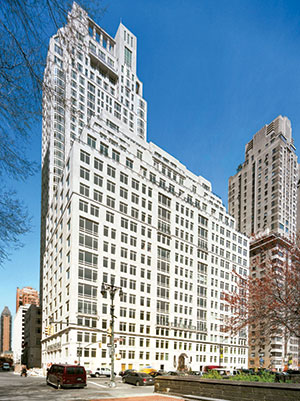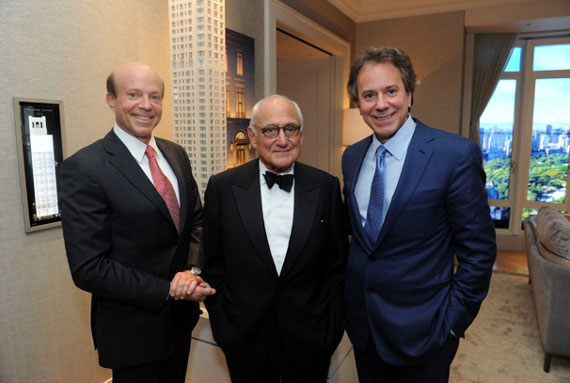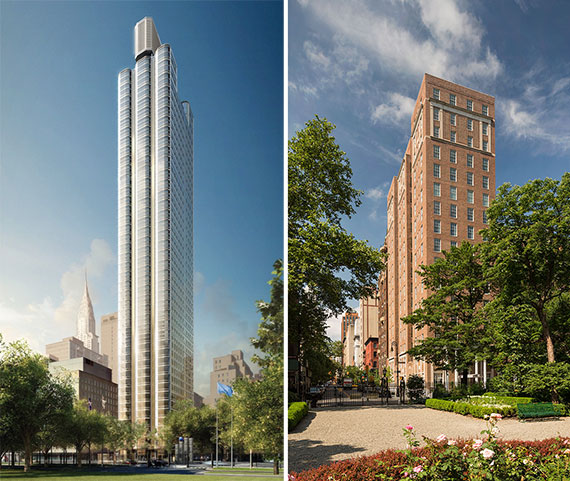To be a Zeckendorf, one of New York City’s most influential real estate families, is to be both inspired and haunted by the past.
William Zeckendorf Sr., or “Big Bill,” was a beefy mogul who famously assembled some 75 parcels of land on the East Side into a bundle that eventually became the United Nations. At one point, he owned both the Chrysler Building and the Graybar Building. But when the market stalled in the mid-1960s, his creditors called in their loans and his empire came crashing down.
“Big Bill’s” son William Zeckendorf Jr.—who is credited with reshaping the Upper West Side, the Flatiron District and other parts of Manhattan — met a similar fate. At his lowest point, during the recession of the early 1990s, the authorities raided his apartment in the Delmonico Hotel in search of saleable assets.
“I was there,” William Lie Zeckendorf told The Real Deal last month, referring to the recession. “It was horrible. It’s not fun to owe banks money. I never want to owe banks money.”
With that in mind, the third generation of Zeckendorf developers — William and his brother, Arthur — have written their own soaring-but-calculated arc, most notably by building 15 Central Park West, the Robert A.M. Stern-designed condominium that’s become part of New York City real estate lore.

15 Central Park West
To recap, 15 CPW had a total sellout in 2008 of more than $2 billion. It became home to a Who’s Who of New York power brokers, from Goldman Sachs CEO Lloyd Blankfein to Yankees slugger A-Rod; provided fodder for hundreds of Page Six stories; and was the subject of a book by real estate scribe Michael Gross. In short, it is considered the city’s most successful and game-changing luxury condo.
Not surprisingly, it’s a hard act to follow.
Since 15 CPW, the brothers have only taken on two projects —18 Gramercy Park South and 50 United Nations Plaza. But their next luxury condo tower, 520 Park Avenue, which is slated to be finished in 2018, is arguably their most ambitious undertaking since.

Arthur and William Lie Zeckendorf with Robert A.M. Stern
The 33-unit building — which was also designed by Stern, who described it as “an elegant spear of asparagus rising out of the ground” — will have the same understated style of 15 CPW: clad head to toe in the same Indiana limestone and boasting white oak and marbled residences along with a French walnut wood lobby equipped with a fireplace. It will also have some of the same high expectations. Prices at 520 Park start at $20.5 million. The triplex penthouse is asking $130 million.
But as a flood of new ultra-high-end residential inventory puts downward pressure on prices at the top end of the Manhattan market, industry insiders are questioning the financial underpinnings of 520 Park. Among the challenges the brothers face is retaining an edge in a market that’s replicated their signature aesthetic — that old-fashioned, pre-war apartment building glamour.

520 Park Avenue
Ultimately, sources said, 520 Park, like its competitors, will pose an important test for the uber luxury market — and of the Zeckendorfs’ own appetite for risk.
“They’ve gone out on a limb and gotten pretty risky with this project,” said one real estate broker who’s worked with the brothers. “520 Park is undeniably beautiful but it’s up against fierce competition. There are a lot of developers going for the same type of buyer with the same high numbers.”
Ask the Zeckendorfs, however, and they point to a history of defying doubters. Early in their careers, in the late 1990s, they hit a home run with a condo conversion at 515 Park Avenue, landing prices of $2,000 a foot when those figures were unheard of.
And when they purchased the 15 CPW site, critics scoffed at the mammoth price they paid for the dirt — $401 million.
“We flogged that deal to the finance community for years. No one wanted to do it because we couldn’t find any comps,” William said. “Whitehall, or Goldman Sachs, turned us down twice before saying yes on the third time around.”
15 CPW’s ‘sister building’
With its vaunted Park Avenue address and starchitect, 520 Park has been touted by the Zeckendorfs as 15 CPW’s “sister building.”
Whether the market sees it that way remains to be seen.
The project — which has a total sellout price of $1.2 billion — is indisputably top-notch, but some say the location is second-rate compared to 15 CPW. While the building has Central Park views, unlike 15 CPW, it’s not directly on the park. And, it does not actually have frontage on Park Avenue.
It’s also said to be missing one key amenity that many wealthy buyers have come to expect— a motor court, which rival buildings 432 Park and 220 Central Park South both have.
“Rich people need a place where they can drive into the property,” said one top broker, who asked to remain anonymous. “They don’t want to wait around while a valet parks cars.”
While 520 Park’s footprint did not allow for a motor court, it does have valet parking.
In the end, the developers have clearly maximized the parcel.
The Zeckendorfs spent close to 14 years assembling the site, starting with two tenement buildings they picked up in the late 1980s on East 60th Street just west of Park Avenue. The mid-block sites could have been razed to make way for a low-rise condo. But the Zeckendorfs wanted to build something larger — and with a more significant payoff.
In 2013, after more than a decade of negotiations, they shelled out $37 million, or a record-setting $430 per square foot, to acquire roughly 70,000 square feet of air rights from the adjacent Grolier Club — a private club and society of bibliophiles —and Christ Church. The deal gave them the right to build a far taller building that would cantilever over the club.
But those air rights also significantly upped their cost basis for the project.
And in addition to that higher basis, they’re plunking down another $30,000 a year for the next 100 years for the right to use the church’s prestigious Park Avenue address.
A crowded market
The question now is how 520 Park will stack up in today’s Billionaires’ Row era.
Back in 2005, when sales launched at 15 CPW, only 25 Manhattan deals closed for more than $20 million.
That building certainly had rivals: The iconic Plaza Hotel launched its condo component in 2006 and sales were in full swing at Vornado Realty Trust’s One Beacon Court. But the amount of ultra-high-end inventory was nowhere near what it is today.
“Objectively speaking, is there more competition today? Yes, there is,” William acknowledged.

A conceptual rendering of Billionaires Row (Credit: Visualhouse)
Indeed, as of last month, there were 168 Manhattan apartments listed for more than $20 million, with many more in the pipeline. On Billionaires’ Row alone, sales are underway at Extell Development’s One57, Vornado’s 220 Central Park South, JDS Development and Property Markets Group’s 111 West 57th Street and Macklowe Properties and CIM’s 432 Park Avenue.
The Zeckendorfs declined to comment on exactly how many units they’ve put into contract at 520 Park since sales launched there last spring. Arthur said only that “sales have exceeded our business plan.” But sources told TRD that, much like other luxury buildings, units haven’t been flying off the shelf.
The same is true at 50 UN Plaza, where the brothers launched sales in 2013. Just over half of the 88 apartments at the Norman Foster-designed tower have closed, the developers confirmed. Prices, the Zeckendorfs said, have been cut by 5 percent on some units. But the brothers said they’re not overly concerned with sales velocity at the project and will stick firmly to their prices, which range from $2.2 million to $70 million for the duplex penthouse. Prices at the project average at least 50 percent more than prices at Trump World Tower and 100 United Nations Plaza, the neighborhood’s priciest properties.

50 United Nations Plaza and 18 Gramercy Park South
William said he believes the market softening is just a short-term blip.
“Are we in a market pause? Sure,” he said. “[But] the fact is that there are still a lot of buyers out there in the market. I believe the wind is still at our backs.”
William said some of the most highly anticipated projects may “overpromise and under-deliver.”
Meanwhile, when asked about Extell’s One57, Arthur, who sat down with TRD at 15 CPW’s private residents-only restaurant last month, didn’t seem impressed. “It’s like Metropolitan Tower,” he said, referring to the 1987 condo that was the “it” building of its time but has since lost some of its luster.
“There are far more billionaires between Park and Fifth than there are on Billionaires’ Row. So, Billionaires’ Row is what? Three billionaires?” he added.
However, some warn that it can be better to take slightly lower prices when the market is softening than to overreach.
“You can’t hit a home run every time you go out,” said luxury broker Donna Olshan. “Sometimes you have to shoot for singles and doubles. It’s a lot harder than it was out there.”
Big backers
The Zeckendorfs believe they are well prepared to withstand a slowdown, thanks to deep-pocketed backers and the discipline they’ve exercised by taking on just one building at a time.
At 520 Park, the brothers are partnered with Global Holdings, run by Monaco-based private investor Eyal Ofer, along with investors Ezra and Rafael Nasser.

Eyal Ofer
Along with Goldman Sach’s real estate arm, Whitehall, Ofer — a billionaire eight times over and the son of Sammy Ofer, once Israel’s richest man — put up the majority of the money for the Zeckendorfs’ 15 CPW.
Myers Mermel of Mermel and McClain, the broker who put together the air rights deal for the Zeckendorfs, said the brothers’ “staying power comes from capital partners who believe in them.”
Arthur put it this way: “There are three types of developers. There are the publicly traded REITs who have to deliver returns in a certain time frame, the undercapitalized smaller developers out there looking for loans and the wealthy private developers like us.”
Developers in the third category have more flexible timelines to generate returns for investors, he said, noting that they’re not under the gun to sell fast and slash prices. It’s easier for private money to work with private money, William said.
“It’s a good combination,” he said. “We used to work with Goldman Sachs, and while that was good, it wasn’t perfect. They had more of a short-term view.”
He added: “This is not a business of short-term results. If you’re impatient and you need immediate results, you should go become a day trader and trade gold or something.”
Fallback plan
The brothers have also tried to shelter themselves from risk by fostering a reliable stream of annual income from their brokerage business Terra Holdings, which owns both Brown Harris Stevens and Halstead Property.
William said having that additional outlet reduces the pressure to constantly develop.
The brothers partnered with investors Kent Swig and David Burris to buy BHS in 1995 from real estate titan Harry Helmsley and his wife, Leona, who had just served 30 months in prison after being convicted of tax evasion.
They bought the company for an undisclosed-but-steeply-discounted sum on the heels of another major scandal, in which 17 employees of the company were charged with taking kickbacks from contractors and suppliers. At the time, the firm represented a string of high-profile buildings, including the Dakota, but had struggled with bad management.
“They came in with not only great knowledge and support, but with funds,” said Hall Willkie, president of BHS.
The brothers got to work repairing the company’s image and expanding its reach. In 2001, they bought Halstead, which was still owned by Clark Halstead. In TRD’s last residential firm ranking in the spring, the two firms had a combined 635 agents.
While the Zeckendorfs have not grown the firms as rapidly as Elliman and Corcoran, now the city’s two largest residential brokerage firms, the company is thriving, with BHS specializing in high-end sales and Halstead churning out a high volume of deals.
While Terra is a private company and is not required to file public financial disclosures, William said it has no debt.
“We always said we’d own the company debt-free and we’ve stayed true to that,” he said.
‘Blood is thicker than water’
Just a year apart in age, the brothers are nevertheless a study in contrasts.
Arthur, 56, is measured with his words. William, 57, is more gregarious and often acts as the company’s public face, sources said. But Arthur said that he often appears at real estate industry events and attended last year’s Real Estate Board of New York residential gala.
The two have worked side by side since they were teens working for their father’s real estate empire. And rather than strictly dividing up duties like many family-run firms do, they both work on everything from design to sales to financing.
“They remind me of the way New York used to be,” Mermel said. “Business used to be done without a lot of bluff and bluster. They come without all the drama that a lot of today’s developers seem to relish.”
And, interestingly, the low points of their father ‘s and grandfather’s pasts seem to have only enhanced the value of their brand. Those two earlier generations may serve as cautionary tales, but the real estate industry has respect for risk-takers, and everyone loves a good comeback story.
Still, even those that do business with the brothers are unclear about how close they are and how they interact behind the scenes.
“They’re very guarded and meticulous in their decision-making,” said commercial broker Dustin Stolly of JLL, who helped arrange the financing for 520 Park. “In the open, you never really get the sense that they differ in their views.”
But sources told TRD that, in private, the brothers aren’t always on the same page.
One insider, who asked to be unnamed, said, “They stick together when there’s a fight — blood is thicker than water — but, on a personal level, I’m not sure they have much to do with each other.”
The two asked to be interviewed separately for this story.
On their relationship, William said: “We always agree on the big stuff — what kinds of apartments to build, which architect to select, which contractor to use.”
If there is any discord, none of it seems to have affected the business.
“They have a track record that’s the envy of everyone in the real estate industry,” said Michael Graves, a luxury broker at Douglas Elliman. “They have a brand identity that people will buy into.”
The Zeckendorfs are determined to see that untarnished reputation remain intact, even as the high-end market begins to show signs of faltering.
“We don’t do debt, we don’t do recourse debt and we only do one project at a time,” William said. “If the music stops, you can come see me right here in this chair.”
Correction: A previous version of this post identified 520 Park as a 33 unit building to be delivered next year. The building has 31 units and won’t be completed until 2018.